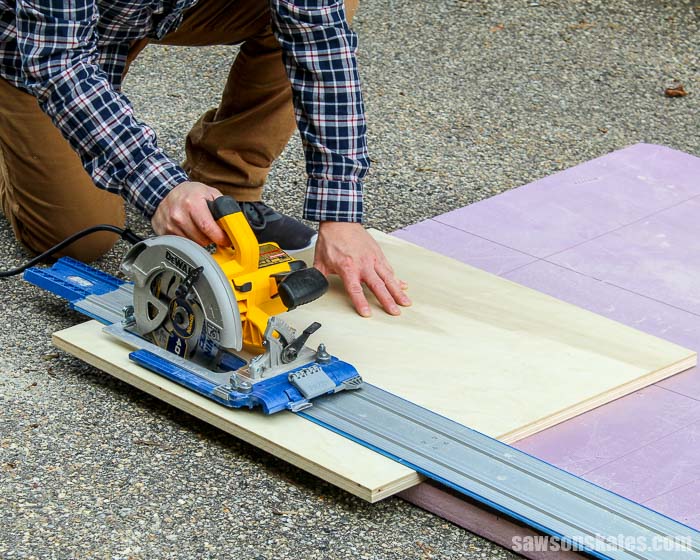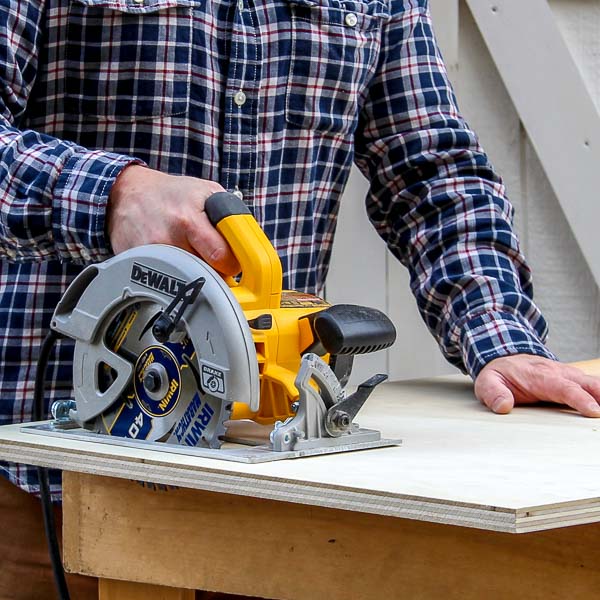Do circular saws cut straight? Well, that’s a question many DIY enthusiasts and woodworkers often find themselves asking. Let’s dive in and explore this handy tool together!
Now, when it comes to cutting straight lines, circular saws are definitely up for the task. These powerful tools can slice through various materials like wood, metal, and even plastic with precision and accuracy.
But before we go any further, let’s understand how circular saws work their magic. You see, these saws have a circular blade with sharp teeth that spins rapidly as you cut through the material. This spinning motion, combined with the guide or fence attached to the tool, helps ensure a straight cut, reducing the chances of any unwanted curves or wobbles.
So, whether you’re building a bookshelf or working on a woodworking project, a well-maintained and properly adjusted circular saw can be your best friend in creating clean and straight cuts.
Get straight to the point with circular saws! These versatile tools are designed to make precise cuts, but ensuring straight cuts requires some finesse. Follow these expert tips to ensure your circular saw cuts stay perfectly straight:
- Tighten the blade and check for any warping.
- Use a guide or a straight edge to align the saw.
- Mark your cut line and position the saw correctly.
- Maintain a steady pace and apply consistent pressure.
- Keep your eye on the cut line for accuracy.
With these steps, you’ll be making straight cuts with a circular saw like a pro!

Do Circular Saws Cut Straight?
Understanding Circular Saws
Circular saws are a versatile and powerful tool used in woodworking and construction projects. They consist of a circular blade with sharp teeth that spin rapidly to cut through various materials, including wood, metal, and plastic. While circular saws are known for their ability to make precise and accurate cuts, many people wonder if they can indeed cut straight. In this article, we will delve into the factors that affect the straightness of cuts made with circular saws. Whether you are a professional contractor or a DIY enthusiast, understanding how to achieve straight cuts with a circular saw is crucial for achieving quality results in your woodworking projects.
When it comes to cutting straight with a circular saw, several factors come into play. Here are some important considerations:
1. Blade Quality: The quality of the blade you use in your circular saw plays a significant role in the accuracy of your cuts. High-quality blades with sharp teeth and precision cutting edges are designed to provide clean and straight cuts. Investing in a good-quality blade suited for the material you are cutting is essential for achieving straight and precise results.
2. Blade Alignment: Proper blade alignment is critical for achieving straight cuts with a circular saw. Ensure that the blade is aligned parallel to the saw’s base or shoe. Misalignment can result in the blade veering off, leading to crooked cuts. Regularly check and adjust the alignment of your blade to maintain accuracy.
3. Guide Systems: Many circular saws come equipped with guide systems that assist in making straight cuts. These guide systems include features such as built-in laser guides or guide tracks that help keep the saw on the desired cutting line. Utilizing these guide systems can significantly improve the straightness of your cuts.
4. Cutting Technique: Your cutting technique also plays a crucial role in the straightness of your cuts. Maintain a firm grip on the saw and focus on keeping a steady and consistent motion as you guide the blade along the cutting line. Practice proper body positioning and hand control to ensure a straight and accurate cut.
While circular saws are capable of cutting straight, it is important to note that achieving perfect straight cuts requires practice, skill, and attention to detail. By considering these factors and implementing the right techniques, you can achieve precise and straight cuts with a circular saw.
Benefits of Using a Circular Saw
Circular saws offer several benefits that make them a popular choice for both professionals and DIY enthusiasts. Here are some key advantages of using a circular saw:
1. Versatility: Circular saws are incredibly versatile and can be used for various cutting applications. They can cut through a wide range of materials, including wood, metal, and plastic, making them suitable for different types of projects.
2. Portability: Circular saws are typically lightweight and portable, allowing you to easily transport them to different job sites. This makes them a convenient tool for contractors who need to work in different locations.
3. Speed: Circular saws are designed to make fast and efficient cuts. The powerful motor and sharp blade enable you to complete your cuts quickly, which can save you valuable time on your projects.
4. Accuracy: While achieving perfect straight cuts with a circular saw may require some practice, modern models come with advanced features that improve accuracy. Laser guides, guide tracks, and other built-in systems help you maintain a straight cutting line and achieve precise results.
5. Cost-Effective: Circular saws are generally more affordable compared to other power tools, making them an economical choice for contractors and DIYers. They offer excellent value for money without compromising on performance.
In conclusion, circular saws are capable of cutting straight when used correctly and with the right techniques. By considering factors such as blade quality, alignment, guide systems, and cutting technique, you can achieve accurate and precise cuts with a circular saw. With practice and attention to detail, you can master the art of straight cutting with this versatile tool.”
Key Takeaways: Do Circular Saws Cut Straight?
- Circular saws can cut straight lines when used correctly.
- Proper alignment and guiding techniques are crucial for straight cuts.
- Using a guide or a straight edge can help maintain straight cuts.
- Choosing the right blade and adjusting the saw’s settings is essential for accuracy.
- Regular maintenance and sharp blades contribute to straight cutting performance.
Frequently Asked Questions
Curious about the cutting capabilities of circular saws? Below are some common questions related to the topic.
How do circular saws ensure straight cuts?
Circular saws are designed to cut straight through various materials with precision. One key feature that helps them achieve this is the built-in guide or fence. This guide acts as a reference point, allowing you to guide the saw in a straight line. By aligning the guide with your cutting mark, you can ensure that the saw stays on track and produces a straight cut. Additionally, many circular saws also have laser guides or LED lights that project a straight line onto the material, further aiding in achieving straight cuts.
It’s important to note that the quality of the blade also plays a role in the saw’s ability to cut straight. A sharp, well-maintained blade will reduce the chances of the saw veering off course and help produce cleaner, straighter cuts. Regularly inspecting and replacing the blade when necessary is essential for optimal cutting performance.
Are circular saws suitable for cutting different materials?
Yes, circular saws are versatile tools that can cut through various materials. They are commonly used for cutting wood, but with the right blade, they can also cut through materials like metal, plastic, and even masonry. When selecting a blade for a specific material, consider factors such as tooth configuration and blade material, as these can impact the saw’s cutting performance. It’s crucial to choose the appropriate blade for the material you are working with to ensure clean and efficient cuts.
However, keep in mind that the power and speed of the circular saw may vary depending on the material being cut. For example, cutting through metal may require a slower speed and a blade specifically designed for metal cutting. Always consult the manufacturer’s guidelines and safety instructions to determine the recommended usage of your circular saw for different materials.
Can a circular saw cut curves?
While circular saws are primarily known for their ability to make straight cuts, they can also be used to cut curves. This is typically done by using a technique called “freehand cutting” or “freehand scrolling.” To cut curves, you’ll need to have good control over the saw and be comfortable with guiding it along the desired curved path.
It’s important to note that cutting curves with a circular saw may require some practice and skill, as it can be more challenging compared to using specialized tools like jigsaws or band saws, which are designed specifically for curved cuts. If you have a project that involves intricate curves and tight radius cuts, it may be more efficient to use a tool specifically designed for that purpose.
Can circular saws be used to make angled cuts?
Yes, circular saws can be used to make angled cuts. Most circular saws have an adjustable base or shoe that can be tilted to make bevel cuts at different angles. This allows you to create cuts that are not perpendicular to the material’s surface.
To make accurate angled cuts, you’ll need to adjust the base of the saw to the desired angle before making the cut. Many circular saws have preset angles such as 45 degrees, making it easier to achieve common bevel cuts. However, it’s worth noting that some circular saws may require additional tools, such as a bevel gauge, to accurately set the desired angle.
What safety precautions should I take when using a circular saw?
When using a circular saw, safety should always be a top priority. Here are some essential safety precautions to follow:
First, wear appropriate personal protective equipment (PPE), including safety glasses, hearing protection, and, if necessary, a dust mask or respirator. Always ensure the saw is in good working condition and the blade is properly installed and tightened. Keep your hands away from the blade, using clamps or guides to secure the material being cut. Avoid wearing loose clothing that could get caught in the saw. Finally, never start the saw while the blade is in contact with the material; instead, let the blade reach full speed before making the cut.

Summary
Circular saws are great for many cuts, but they might not always cut perfectly straight. It’s good to use a guide or fence when you want a straight cut. Also, blades can get bent or dull, so make sure to check and replace them when needed. With a little extra effort, you can get your circular saw to cut straight and make clean and precise cuts every time. So, happy cutting!
Remember, practice makes perfect, so don’t get discouraged if your cuts aren’t perfect right away. Keep adjusting, using guides if needed, and you’ll improve over time. Before you know it, you’ll be a pro at cutting straight with a circular saw!
